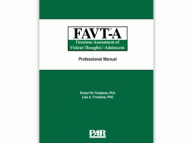The FAVT-A is designed to be a brief, efficient indicator of an individual’s violence potential. Based on the adult version of the FAVT, this 35-item self-report assesses the underlying thoughts that predispose violent behavior in individuals ages 11-18 years. It can help you screen for violence potential, determine whether or not a verbal threat will lead to a violent act, plan clinical intervention, and monitor progress and outcomes.
The items on the FAVT-A are derived directly from clinical material gathered from violent individuals. The items represent thoughts these individuals experienced prior to committing violent acts. Because violent adolescents are able to recognize the exact content of their thoughts in the items, the FAVT-A taps directly into the cognitions of violent adolescents.
FAVT-A items are organized into four Levels (i.e., Paranoid/Suspicious, Persecuted Misfit, Self-Depreciating/Pseudo-Independent, Overtly Aggressive) and two Theoretical Subscales (i.e., Instrumental/Proactive Violence, Hostile/Reactive Violence). This structure enables you to gain a better understanding of the individual and, thus, to offer more targeted treatments.
The FAVT-A was standardized on a sample of 641 individuals that was well-matched to the U.S. population in terms of age, gender, race/ethnicity, and grade level.
In addition, demographic and FAVT-A data on two reference groups (i.e., Incarcerated, Probation) also were collected as part of the standardization process. These data provide you with valuable information for making level-of-care/restriction decisions and for identifying the appropriate intervention intensity.
Two validity scales (i.e., Inconsistency Scale, Negativity Scale) are included to assist you in determining whether the administration is valid.
Change score tables are provided across four different levels of significance for the four normative groups and for the two reference groups so that clinicians can easily find out if a significant change has occurred in an individual’s FAVT-A score over two administrations.
The FAVT-A assists with treatment planning and intervention by enabling you to tap into the cognitive system that drives the adolescent’s violent behavior. It provides you with direct information about the content and intensity of thoughts the adolescent is experiencing along with a clear picture of the adolescent’s perceptions of himself or herself, of others, and of his or her social world. The FAVT-A’s sound theoretical basis enables it to be integrated into many therapeutic approaches, including cognitive-behavioral therapy (CBT), psychodynamic/psychoanalytic therapy, and psychopharmacological treatment.













